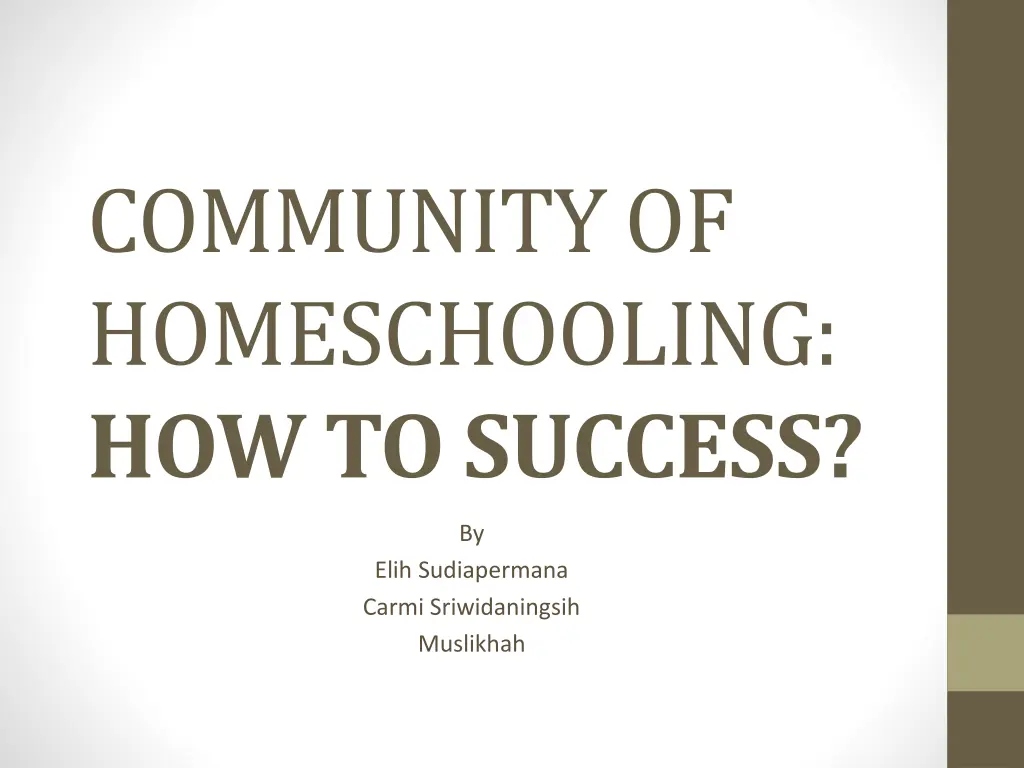
Successful Strategies for Homeschooling Community Development
Discover the success factors behind homeschooling community development in Indonesia, including planning methods and outcomes like college enrollment and entrepreneurship. Explore the models and strategies used to enhance cognitive and non-cognitive development of homeschooled children.
Download Presentation

Please find below an Image/Link to download the presentation.
The content on the website is provided AS IS for your information and personal use only. It may not be sold, licensed, or shared on other websites without obtaining consent from the author. If you encounter any issues during the download, it is possible that the publisher has removed the file from their server.
You are allowed to download the files provided on this website for personal or commercial use, subject to the condition that they are used lawfully. All files are the property of their respective owners.
The content on the website is provided AS IS for your information and personal use only. It may not be sold, licensed, or shared on other websites without obtaining consent from the author.
E N D
Presentation Transcript
COMMUNITY OF HOMESCHOOLING: HOW TO SUCCESS? By Elih Sudiapermana Carmi Sriwidaningsih Muslikhah
Introduction Homeschooling as an alternative route education is increasingly in demand by the community (Vertakova, 2015; Sandi, 2018; Korkmaz, & Duman, 2014). In Indonesia homeschooling seems to be a trend, especially in big cities. According to Kurniasih (2009: 6) at least the existence of homeschooling is about 10% of the total number of children in Indonesia. Reich (2002: 1) states that homeschooling phenomenon. This research management model homeschooling success cognitive and non cognitive development of children? is no longer a "fringe" aims to reveal the community that can drive
METHODS The research used is descriptive qualitative. Descriptive qualitative research in the form of research with case study method or approach (case study). The research location in the district Karawang and Bogor. Every data collection technique, be it questionnaires, interviews, observation and documentation, both have advantages and disadvantages. The techniques used by researchers include observation, interviews and documentation study.
FINDINGS ANDDISCUSSION Planning for the Development of the Potential of Students in the Community Homeschooling ABhome Organizing the Management of the Potential of Students in the Community Homeschooling ABhome Implementation of the Development of the Potential of Students in the Community The Homeschooling ABhome Supervision of the Development of the Potential of Students in the Community Homeschooling ABhome
CONCLUSION The planning model used by the homeschooling community is the allocative planning model. The Organization homeschooling is an organic model. The organic model emphasizes the coordination of all tasks and emphasizes the loyalty of each executive officer. This model is characterized by openness, problem-solving oriented, quick to adapt to circumstances, societal in character, flexible, and the existence of informal relationships. The driving model used by the homeschooling community is more of a driving model wants-satisfaction. The supervisory model that is carried out is functional supervision which only includes internal supervision with its characteristic being an objective and systematic assessment by the organizers and controllers of the organization. The Output of Homeschooling Dominant is non- physical potential, which consists of brain/ intellectual potential, social- emotional intelligence, spiritual intelligence, and fighting power. The community further develops the overall potential. Outcome of community homeschooling 75% go to college, 8% open their own business, 17% without explanation.






















